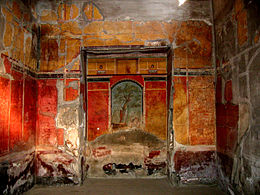Villa Poppaea
It was buried and preserved in the eruption of Vesuvius in 79 AD, like the nearby cities of Herculaneum and Pompeii, about 10 m (33 ft) below modern ground level.
It was one of the luxury villas built along the entire coast of the Gulf of Naples in the Roman period, such that Strabo wrote: The villa was originally built on a shelf 14m above sea level and above the sea shore giving it a beautiful view over the Bay of Naples.
The villa was extended to the east in the age of Claudius (r.41–54 AD) with the addition of a large swimming pool (piscina)[8] bordered on the south and east by trees, with triclinia and peristyles with colonnaded porticoes framing formal gardens and various guest reception and service rooms.
Around the peristyle (21) painted in Fourth-Style stripes was the service area with workrooms and dormitories on the upper floor for slaves, a latrine, a kitchen and a lararium.
Like everywhere else in the region the villa was damaged in the earthquake of AD 62 and renovation and repairs were still being made until its last moments as, for example, some of the columns were found dissembled and garden sculptures away from their proper location indicates.
[10] Like many of the frescoes that were preserved due to the eruption of Mount Vesuvius, those decorating the walls of the Villa Poppaea are striking both in form and in colour.
[13] Much attention has been paid to the allusions to stage painting (scenae frons) in the Villa Poppaea frescoes, particularly those in Room 23.
In 1839 a brief exploration of the site was undertaken by Bourbon excavators using the tunnelling technique employed at Herculaneum, uncovering part of the peristyle and garden area[17] and removing several paintings.
The villa's southernmost portions have been left unexcavated because of the physical limitations of the complex, which has been compromised by its position beneath the modern city of Torre Annunziata and the Sarno aqueduct.
These circumstances, along with more than 400 amphorae recovered in the excavations, indicate the property was devoted to the production of wine, oil, and agricultural goods.
The discovery of a series of weights seems to confirm this theory; a bronze seal found at the site preserved the name of Lucius Crassius Tertius, apparently its last owner.




